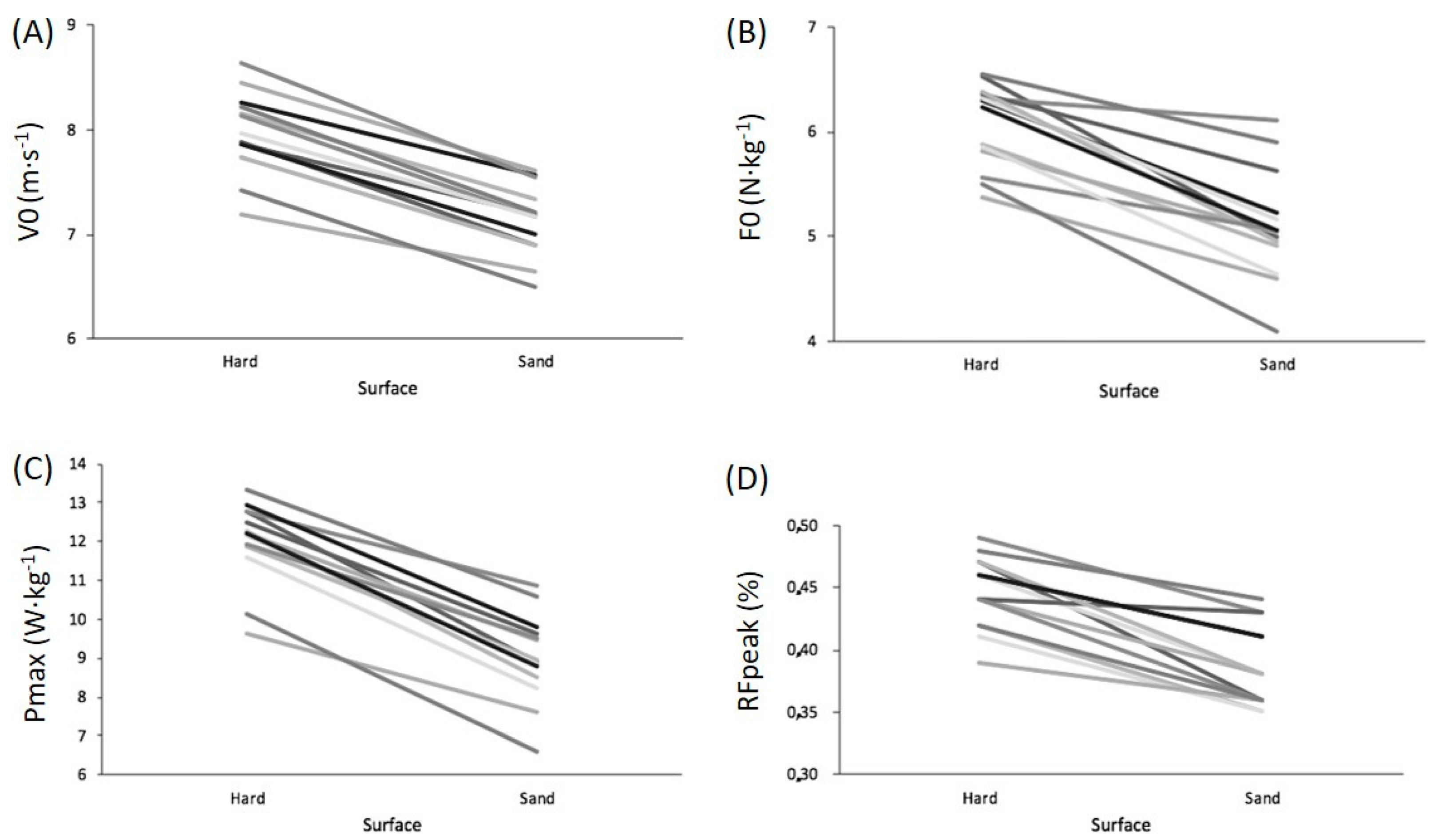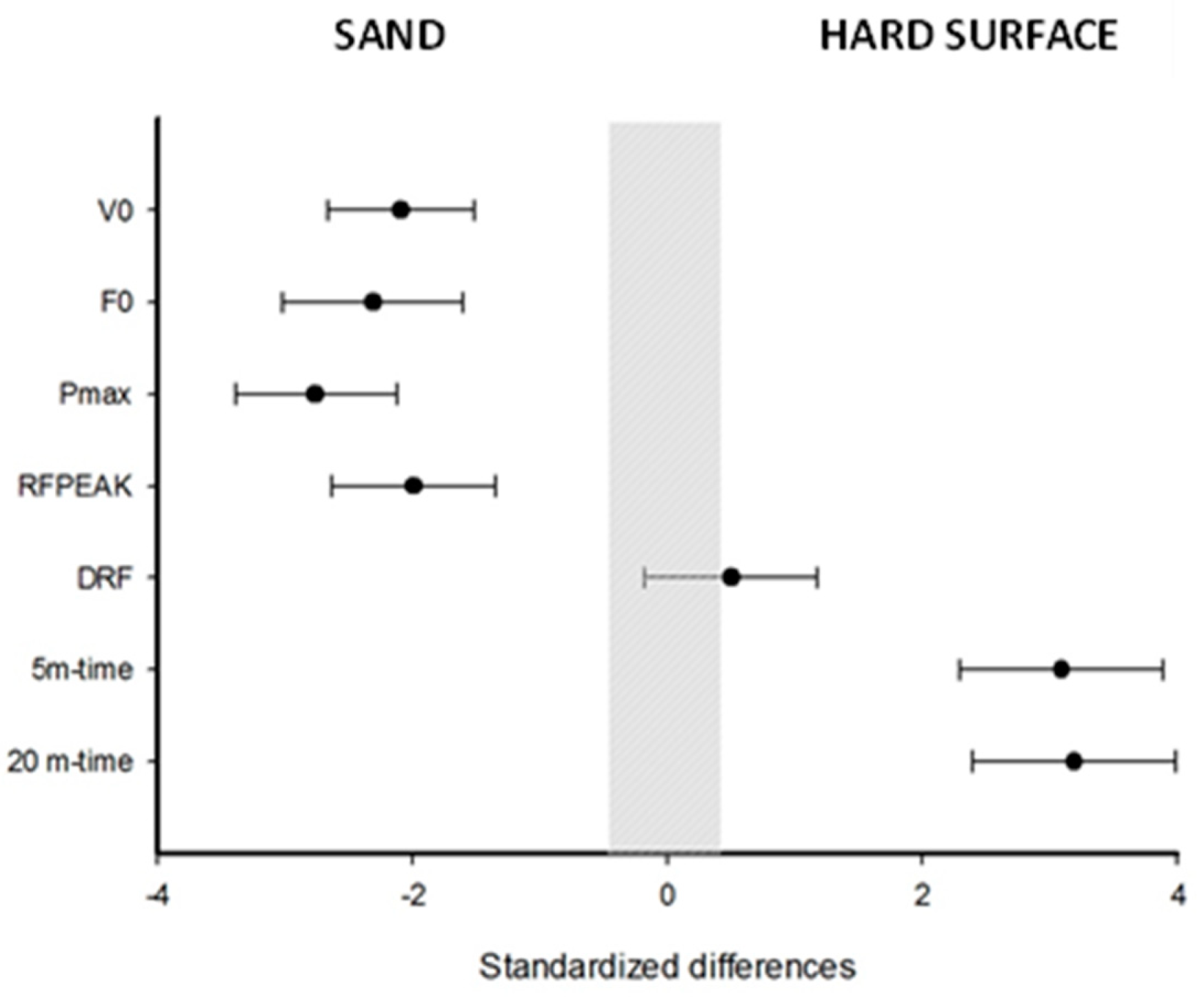Effects of the Surface Type on the Sprint Force–Velocity–Power Profile of Female Beach Handball Top-Level Players
Abstract
1. Introduction
2. Materials and Methods
2.1. Study Design
2.2. Participants
2.3. Testing Procedures
2.4. Statistical Analyses
3. Results
4. Discussion
5. Conclusions and Practical Applications
Author Contributions
Funding
Institutional Review Board Statement
Informed Consent Statement
Data Availability Statement
Acknowledgments
Conflicts of Interest
References
- Ortega-Becerra, M.; Espina-Agulló, J.J.; Pueo, B.; Jiménez-Olmedo, J.M.; Penichet-Tomás, A.; Sellés-Pérez, S. Anthropometric profile and performance indicators in female elite beach handball players. J. Phys. Educ. Sport 2018, 18, 1155–1160. [Google Scholar] [CrossRef]
- Lara Cobos, D. La respuesta cardiaca durante la competición de balonmano playa femenino. Apunts Med. Esport 2011, 46, 131–136. [Google Scholar] [CrossRef]
- Pueo, B.; Jimenez-Olmedo, J.M.; Penichet-Tomas, A.; Ortega Becerra, M.; Espina Agullo, J.J. Analysis of time-motion and heart rate in elite male and female beach handball. J. Sports Sci. Med. 2017, 16, 450–458. [Google Scholar] [PubMed]
- Silva, A.S.; Marques, R.C.S.; Lago, S.D.A.; Santos, D.A.G.; Lacerda, L.M.; Silva, D.C.; Soares, Y.M. Physiological and nutritional profile of elite female beach handball players from Brazil. J. Sports Med. Phys. Fit. 2016, 56, 503–509. [Google Scholar]
- Zapardiel, J.C.; Asín-Izquierdo, I. Conditional analysis of elite beach handball according to specific playing position through assessment with GPS. Int. J. Perform. Anal. Sport 2020, 20, 118–132. [Google Scholar] [CrossRef]
- Gutiérrez-Vargas, R.; Gutiérrez-Vargas, J.C.; Ugalde-Ramírez, J.A.; Rojas-Valverde, D. Kinematics and thermal sex responses during an official beach handball game in Costa Rica: A pilot study. Arch. Med. Deporte 2018, 36, 7–14. [Google Scholar]
- Jiménez-Reyes, P.; Garcia-Ramos, A.; Párraga-Montilla, J.A.; Morcillo-Losa, J.A.; Cuadrado-Peñafiel, V.; Castaño-Zambudio, A.; Samozino, P.; Morin, J.B. Seasonal Changes in the Sprint Acceleration Force-Velocity Profile of Elite Male Soccer Players. J. Strength. Cond. Res. 2022, 36, 70–74. [Google Scholar] [CrossRef] [PubMed]
- Marcote-Pequeño, R.; García-Ramos, A.; Cuadrado-Peñafiel, V.; González-Hernández, J.M.; Gómez, M.Á.; Jiménez-Reyes, P. Association between the force–velocity profile and performance variables obtained in jumping and sprinting in elite female soccer players. Int. J. Sports Physiol. Perform. 2019, 14, 209–215. [Google Scholar] [CrossRef] [PubMed]
- Morin, J.B.; Samozino, P. Interpreting power-force-velocity profiles for individualized and specific training. Int. J. Sports Physiol. Perform. 2016, 11, 267–272. [Google Scholar] [CrossRef]
- Jaric, S. Force-velocity Relationship of Muscles Performing Multi-Joint Maximum Performance Tasks. Int. J. Sports Med. 2015, 36, 699–704. [Google Scholar] [CrossRef]
- Samozino, P.; Rabita, G.; Dorel, S.; Slawinski, J.; Peyrot, N.; de Villarreal, E.S.; Morin, J.B. A simple method for measuring power, force, velocity properties, and mechanical effectiveness in sprint running. Scand. J. Med. Sci. Sports 2016, 26, 648–658. [Google Scholar] [CrossRef] [PubMed]
- Lejeune, T.M.; Willems, P.A.; Heglund, N.C. Mechanics and energetics of human locomotion on sand. J. Exp. Biol. 1998, 201 Pt 13, 2071–2080. [Google Scholar] [CrossRef] [PubMed]
- Penichet-tomás, A.; Ortega-Becerra, M.; Jiménez-olmedo, J.M.; Pueo, B.; Espina-Agulló, J.J. Incidencia lesiva en jugadores españoles de élite de balonmano playa. Incidence of injury in elite Spanish beach handball players. Retos 2019, 36, 83–86. [Google Scholar] [CrossRef]
- Pinnington, H.C.; Lloyd, D.G.; Besier, T.F.; Dawson, B. Kinematic and electromyography analysis of submaximal differences running on a firm surface compared with soft, dry sand. Eur. J. Appl. Physiol. 2005, 94, 242–253. [Google Scholar] [CrossRef] [PubMed]
- Zamparo, P.; Perini, R.; Orizio, C.; Sacher, M.; Ferretti, G. The energy cost of walking or running on sand. Eur. J. Appl. Physiol. 1992, 65, 183–187. [Google Scholar] [CrossRef] [PubMed]
- Pinnington, H.C.; Dawson, B. The energy cost of running on grass compared to soft dry beach sand. J. Sci. Med. Sport 2001, 4, 416–430. [Google Scholar] [CrossRef] [PubMed]
- Gómez-Carmona, C.D.; Rojas-Valverde, D.; Rico-González, M.; De Oliveira, V.; Lemos, L.; Martins, C.; Nakamura, F.; Pino-Ortega, J. Crucial workload variables in female-male elite Brazilian Beach Handball: An exploratory factor analysis. Biol. Sport 2023, 40, 345–352. [Google Scholar] [CrossRef] [PubMed]
- Bahr, R.; Reeser, J.C. New guidelines are needed to manage heat stress in elite sports—The Fédération Internationale de Volleyball (FIVB) Heat Stress Monitoring Programme. Br. J. Sports Med. 2012, 46, 805–809. [Google Scholar] [CrossRef] [PubMed]
- De Faria Pastore, J.C.; De Azevedo Ferreira, C.A.; Henrique Da Costa, F.C.; Joao, P.V. Evaluation of Variables According to Agility, Speed, and Power to the Type of Sand of Different Beaches for the Practice of Beach Volleyball. Int. J. Sports Phys. Educ. 2017, 3, 1–8. [Google Scholar] [CrossRef]
- Impellizzeri, F.M.; Rampinini, E.; Castagna, C.; Martino, F.; Fiorini, S.; Wisloff, U. Effect of plyometric training on sand versus grass on muscle soreness and jumping and sprinting ability in soccer players. Br. J. Sports Med. 2008, 42, 42–46. [Google Scholar] [CrossRef]
- Giatsis, G.; Kollias, I.; Panoutsakopoulos, V.; Papaiakovou, G. Volleyball: Biomechanical differences in elite beach-volleyball players in vertical squat jump on rigid and sand surface. Sports Biomech. 2004, 3, 145–158. [Google Scholar] [CrossRef] [PubMed]
- Cohen, J. Statistical Power Analysis for the Behavioral Sciences, 2nd ed.; Hillsdale, L., Ed.; Erlbaum Associates: Mahwah, NJ, USA, 1988; p. 567. [Google Scholar]
- Hopkins, W.G.; Marshall, S.W.; Batterham, A.M.; Hanin, J. Progressive statistics for studies in sports medicine and exercise science. Med. Sci. Sports Exerc. 2009, 41, 3–13. [Google Scholar] [CrossRef] [PubMed]
- Gaudino, P.; Gaudino, C.; Alberti, G.; Minetti, A.E. Biomechanics and predicted energetics of sprinting on sand: Hints for soccer training. J. Sci. Med. Sport 2013, 16, 271–275. [Google Scholar] [CrossRef] [PubMed]
- Sánchez-Malia, J.M.; Rodiles-Guerrero, L.; Pareja-Blanco, F.; Ortega-Becerra, M. Determinant factors for specific throwing and physical performance in beach handball. Sci. Sports 2022, 37, 141.e1–141.e6. [Google Scholar] [CrossRef]
- Wise, F. Kinematic Gait Characteristics in Hard Surface and Sand Surface During Maximum Sprint. Mo. J. Health Phys. Educ. Recreat. Dance 2008, 18, 120. [Google Scholar]
- Alcaraz, P.E.; Palao, J.M.; Elvira, J.L.L.; Linthorne, N.P. Effects of a sand running surface on the kinematics of sprinting at maximum velocity. Biol. Sport 2011, 28, 95–100. [Google Scholar] [CrossRef]
- Jimenez-Reyes, P.; Samozino, P.; Garcia-Ramos, A.; Cuadrado-Peñafiel, V.; Brughelli, M.; Morin, J.B. Relationship between vertical and horizontal force-velocity-power profiles in various sports and levels of practice. PeerJ 2018, 6, e5937. [Google Scholar] [CrossRef] [PubMed]
- Hammami, M.; Bragazzi, N.L.; Hermassi, S.; Gaamouri, N.; Aouadi, R.; Shephard, R.J.; Chelly, M.S. The effect of a sand surface on physical performance responses of junior male handball players to plyometric training. BMC Sports Sci. Med. Rehabil. 2020, 12, 26. [Google Scholar] [CrossRef] [PubMed]
- Moss, S.L.; McWhannell, N.; Michalsik, L.B.; Twist, C. Anthropometric and physical performance characteristics of top-elite, elite and non-elite youth female team handball players. J. Sports Sci. 2015, 33, 1780–1789. [Google Scholar] [CrossRef]
- Prieske, O.; Chaabene, H.; Puta, C.; Behm, D.G.; Büsch, D. Effects of Drop-Height on Jump Performance in Male and Female Elite Adolescent Handball Players. Int. J. Sports Physiol. Perform. 2019, 14, 674–680. [Google Scholar] [CrossRef]
- Manchado, C.; Tortosa-Martínez, J.; Vila, H.; Ferragut, C.; Platen, P. Performance factors in women’s team handball: Physical and physiological aspects—A review. J. Strength. Cond. Res. 2013, 27, 1708–1719. [Google Scholar] [CrossRef] [PubMed]
- Wagner, H.; Finkenzeller, T.; Würth, S.; Von Duvillard, S.P. Individual and team performance in team-handball: A review. J. Sports Sci. Med. 2014, 13, 808. [Google Scholar] [PubMed]
- Morin, J.B.; Edouard, P.; Samozino, P. Technical ability of force application as a determinant factor of sprint performance. Med. Sci. Sports Exerc. 2011, 43, 1680–1688. [Google Scholar] [CrossRef] [PubMed]
- Morin, J.B.; Petrakos, G.; Jiménez-Reyes, P.; Brown, S.R.; Samozino, P.; Cross, M.R. Very-Heavy Sled Training for Improving Horizontal-Force Output in Soccer Players. Int. J. Sports Physiol. Perform. 2017, 12, 840–844. [Google Scholar] [CrossRef]
- Fernandez-Fernandez, J.; Nakamura, F.Y.; Boullosa, D.; Santos-Rosa, F.J.; Herrero-Molleda, A.; Granacher, U.; Sanz-Rivas, D. The Effects of Neuromuscular Training on Sand Versus Hard Surfaces on Physical Fitness in Young Male Tennis Players. Int. J. Sports Physiol. Perform. 2023, 19, 71–79. [Google Scholar] [CrossRef]


| Hard Surface | Sand | % Δ | p-Value | r Correlation | p-Value (Correlation) | |
|---|---|---|---|---|---|---|
| F0 (N·kg−1) | 6.07 ± 0.39 | 5.10 ± 0.52 | −15.98 | <0.001 | −0.045 | 0.870 |
| V0 (m·s−1) | 7.96 ± 0.38 | 7.11 ± 0.33 | −10.67 | <0.001 | 0.691 | 0.003 |
| Pmax (W·kg−1) | 12.02 ± 1.02 | 9.02 ± 1.11 | −24.95 | <0.001 | 0.520 | 0.035 |
| DRF (%) | −7.00 ± 0.48 | −6.75 ± 0.59 | −3.57 | NA | NA | NA |
| RFpeak (%) | 0.44 ± 0.02 | 0.38 ± 0.03 | −13.63 | <0.001 | −0.254 | 0.342 |
| 5 m time (s) | 1.52 ± 0.05 | 1.68 ± 0.79 | 10.52 | <0.001 | 0.130 | 0.633 |
| 20 m time (s) | 3.09 ± 0.94 | 3.41 ± 0.14 | 10.35 | <0.001 | 0.753 | 0.003 |
| Top Speed (m·s−1) | 7.58 ± 0.34 | 6.67 ± 0.42 | 7.80 | <0.001 | 0.807 | <0.001 |
Disclaimer/Publisher’s Note: The statements, opinions and data contained in all publications are solely those of the individual author(s) and contributor(s) and not of MDPI and/or the editor(s). MDPI and/or the editor(s) disclaim responsibility for any injury to people or property resulting from any ideas, methods, instructions or products referred to in the content. |
© 2024 by the authors. Licensee MDPI, Basel, Switzerland. This article is an open access article distributed under the terms and conditions of the Creative Commons Attribution (CC BY) license (https://creativecommons.org/licenses/by/4.0/).
Share and Cite
Lara-Cobos, D.; Martínez-Aranda, L.M.; Sanz-Matesanz, M.; Cuadrado-Peñafiel, V.; Ortega-Becerra, M. Effects of the Surface Type on the Sprint Force–Velocity–Power Profile of Female Beach Handball Top-Level Players. Appl. Sci. 2024, 14, 2952. https://doi.org/10.3390/app14072952
Lara-Cobos D, Martínez-Aranda LM, Sanz-Matesanz M, Cuadrado-Peñafiel V, Ortega-Becerra M. Effects of the Surface Type on the Sprint Force–Velocity–Power Profile of Female Beach Handball Top-Level Players. Applied Sciences. 2024; 14(7):2952. https://doi.org/10.3390/app14072952
Chicago/Turabian StyleLara-Cobos, Daniel, Luis Manuel Martínez-Aranda, Manuel Sanz-Matesanz, Víctor Cuadrado-Peñafiel, and Manuel Ortega-Becerra. 2024. "Effects of the Surface Type on the Sprint Force–Velocity–Power Profile of Female Beach Handball Top-Level Players" Applied Sciences 14, no. 7: 2952. https://doi.org/10.3390/app14072952
APA StyleLara-Cobos, D., Martínez-Aranda, L. M., Sanz-Matesanz, M., Cuadrado-Peñafiel, V., & Ortega-Becerra, M. (2024). Effects of the Surface Type on the Sprint Force–Velocity–Power Profile of Female Beach Handball Top-Level Players. Applied Sciences, 14(7), 2952. https://doi.org/10.3390/app14072952









